Physical Address
304 North Cardinal St.
Dorchester Center, MA 02124
This chapter is based on the author's previous publications on this topic.
Management of patients with primary melanoma in vertical growth phase who have no evidence of regional nodal metastases on palpation or ultrasound has been controversial for many years.
Until recently, the treatment options were:
observation with lymphadenectomy delayed until regional metastases became clinically evident (watch and wait),
elective (prophylactic) regional lymph node dissection after microscopic identification of a primary melanoma ( Fig. 28.1 ).
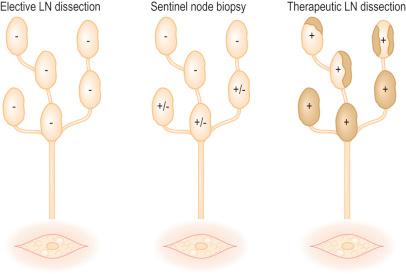
Neither option is ideal. While observation spares the approximately 80% of patients who never develop regional nodal metastases from morbid lymph node surgery:
it delays lymphadenectomy beyond the optimum time for the 20% of patients who develop regional metastases,
it allows melanoma metastases to spread to nonsentinel nodes (NSNs),
it permits the evolving melanoma to achieve a higher AJCC stage.
To resolve this dilemma, Morton, Cochran, and colleagues at UCLA and The John Wayne Cancer Institute developed the techniques of lymphatic mapping (LM) and sentinel node biopsy (SNB).
Studies of melanoma patients early in the evolution of regional nodal tumor spread showed that most had metastatic melanoma in a single node, the remaining lymph nodes in the regional basin being free of tumor. From this observation, we hypothesized that if it were possible to identify the individual node that was susceptible to these earliest metastases for surgical excision and histologic scrutiny, it would be possible to accurately stage the regional basin on the basis of a relatively minor surgical procedure. Lymphoscintigraphy, in which a radioactive isotope, such as 99mTc antimony sulfide, is injected around the site of a primary tumor, reliably identifies the lymph node basin(s) that receive lymph from that specific site. If the lymphoscintigram is read ‘early’, it is possible to identify the individual lymph node that first receives the isotope ( Fig. 28.2 ). The location of that node can then be marked on the overlying skin. Animal experiments had previously shown that marker dye injected in anatomically definable areas of the skin drained reliably to a specific lymph node ( Fig. 28.3 ). Combination of lymphoscintigraphy and intraoperative insertion of vital dye and isotope permitted the reliable identification of the first lymph node on the direct lymphatic drainage pathway from a primary melanoma, which, because it ‘guards’ the remaining lymph nodes of the group, we called the sentinel node (SN) ( Fig. 28.4 ). In a study of 223 melanoma patients who had an SNB followed by completion lymph node dissection (CLND) regardless of whether or not the SN contained melanoma, we showed that if the SN was tumor free there was a less than 1% chance that NSNs would contain metastases. If the SN contained tumor, there was a 16% chance that NSN would contain metastases. These findings led to the development of an NIH-funded international randomized clinical trial (MSLT-I) in 2001. This compared (1) patients with intermediate-thickness primary melanoma (1 mm and thicker or Clark level IV of any thickness), without clinically detectable regional or disseminated metastatic melanoma, who had wide excision and SNB with immediate CLND if the SN contained tumor, followed by observation, with (2) CLND only if the patients developed clinically detectable nodal metastases during observation. Analysis of the results of MSLT-I has shown that SNB is a low-morbidity procedure and is the most accurate staging technique available for melanoma. Patients treated by SNB with immediate CLND if the SN contained tumor had significantly longer disease-free survival relative to observed patients. Patients who had CLND delayed until nodal metastasic disease became clinically detectable, had significantly more tumor-positive nodes, were staged at a higher AJCC level, and had a significantly less favorable survival than patients with tumor in the SN who had an immediate CLND.
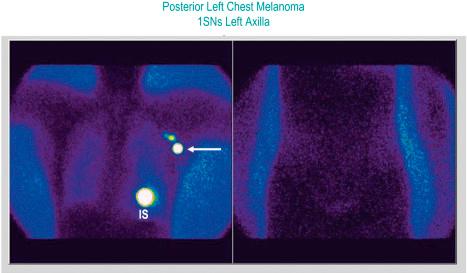
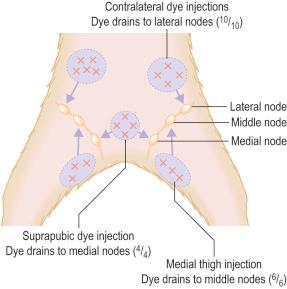
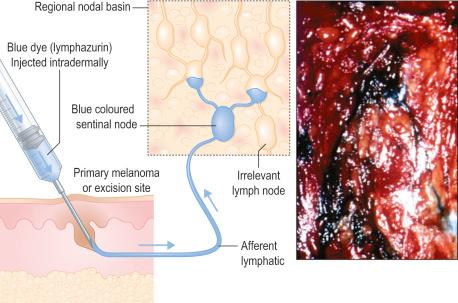
LM and SNB, in addition to wide use in the management of patients with cutaneous melanoma, have been applied to nonmelanoma skin cancers, including Merkel cell carcinoma, squamous carcinoma, and appendageal carcinomas. The techniques are also used to manage patients with cancers of organs other than the skin. SN procedures have been widely performed for breast cancer. The approach is also used for patients with cancers of the upper and lower gastrointestinal tract, vulva and cervix, lung, and thyroid.
Accurate identification of the true SN and its precise histopathological assessment are essential for accurate staging, individualized prediction of the likelihood of metastases in NSNs, subsequent extranodal metastases, and death from melanoma. SN tumor status also assists in determination of the need for additional surgical and nonsurgical therapy. The responsibility for correct identification of the SN lies with the nuclear medicine physicians and surgeons. Correct determination of the presence or absence of tumor in the SN is the responsibility of the pathologist .
SNs arrive at the laboratory, fixed or fresh, as a single cleanly dissected lymph node, a single node in a mass of fat, or as multiple nodes embedded in fat. Surgeons may mark SN with clips or stitches to indicate where afferent lymphatics enter the node, to localize blue-stained segments of the node (evidence supporting SN status) and to highlight areas suspicious for tumor. Requisition forms usually refer to the nodes as SNs, less often as ‘blue nodes’, and occasionally simply imply SN status by appending the radioactive count detected intraoperatively.
Most patients have a single SN, but two and three nodes claimed to be SNs may be submitted. The number of nodes claimed as sentinel may reflect:
the timing of isotope introduction at lymphoscintigraphy,
whether additional isotope is injected at the beginning of surgery,
the time taken by the surgeon to detect all lymph nodes that demonstrate increased radioactivity.
If many lymph nodes are submitted, the specimen is probably the product of a partial regional lymph node dissection rather than a true SNB. SNB, as originally described, provides a limited specimen that contains critical metastasis-susceptible nodal tissue, permitting a more detailed examination than is practicable for the multiple lymph nodes included in lymphadenectomy specimens. Surgeons need to be aware that there are significant labor and expense issues when SN evaluation is required for specimens that contain multiple lymph nodes.
SN specimens are most informative if they are free of artifacts due to crush or cautery. SN may be partially dissected free of associated fat by the pathologist to facilitate processing, but it is good practice to leave a rim of fat so that entering lymphatics can be assessed for the presence of tumor. During dissection, the SN should be examined for blue coloration ( Fig. 28.5 ) (although dye has usually dispersed by the time the specimen arrives at the laboratory). SN are measured (maximum length × width × thickness in millimeters) and exactly bisected through the longest meridian because melanoma cells first reach the subcapsular sinus via the afferent lymphatics, which mostly enter the node in the plane of the central meridian. Cut surfaces are scrutinized for metastases, collections of melanin, or carbon pigment (from tattoos or deliberately introduced by the surgeon). This inspection is improved by use of a hand lens or dissecting microscope. Imprints can be prepared at this stage for cytological evaluation (see below). The SN halves are placed cut face down in cassettes and fixed in formalin ( Fig. 28.6 ), ideally for 12–24 hours, although a lesser period may be acceptable if the specimen arrived at the laboratory in an appropriate volume of formalin. Larger nodes may need to be cut more extensively, but additional slices should be cut parallel to the initial cut and parallel to the meridian.
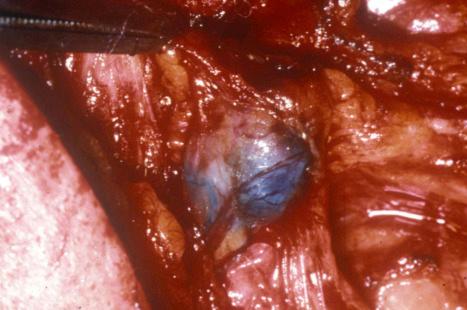

Correct identification of the SN is primarily the responsibility of the nuclear medicine physicians and surgeons. Because of technical problems during nuclear medicine and surgical procedures, lymph nodes submitted as sentinel may not be true SN. Tumor within an SN can obstruct and divert lymph flow to another node, leading to incorrect designation of that node that contains blue dye and shows enhanced radioactivity as sentinel. Preoperative ultrasonography can identify nodal metastases larger than 5 mm (and some claim that smaller deposits are detectable by ultrasound). If putative tumor deposits detected by ultrasound are confirmed as melanoma by fine needle aspiration, the patient may be considered for CLND instead of SNB.
The accuracy of currently used mapping agents is time dependent. The blue dye is not usually visible by the time that the SN is examined in the laboratory, and may have passed on to second-tier (nonsentinel) nodes. The radioactive isotope decays rapidly from the peak emission values measured in the operating room, and few laboratories have the equipment or expertise necessary to measure radioactivity. There is a need for a stable, inert marker that, after intradermal injection with the blue dye/isotope mixture, would selectively accumulate in SN and be readily visible on standard microscopic examination. Such a reagent would allow pathologists to confirm the actual status of nodes claimed to be sentinel.
Carbon particles injected intradermally with blue dye accumulate preferentially and usually exclusively in SN. Particles accumulate in subcapsular sinuses and lymphoid tissues around the entry point of afferent lymphatics ( Fig. 28.7 ). The location of these particles fortuitously indicates the area of the lymph node most likely to harbor metastatic tumor cells, since the carbon particles are delivered to the SN via the same lymphatics as tumor cells shed by the primary melanoma. This approach cannot be used in patients with carbon-based permanent black tattoos of skin in the catchment area of the SN because tattoo pigment frequently tracks to regional lymph nodes. Drug regulations vary from country to country, and widespread use of this interesting and potentially valuable technique must await the clearance of substantial regulatory hurdles.

In Australia, antimony sulfur colloid is routinely used for lymphoscintigraphy prior to SNB. Scolyer and coauthors report the use of inductively coupled plasma mass spectrometry of tissue sections to confirm SN status by detection of increased amounts of antimony: however, this approach is still in development and is not presently available for routine use.
Accurate determination of the presence or absence of tumor in the SN is essential for correct staging of patients and to allow planning of optimal management. Identification of tumor status of an SN may be difficult as the amount of tumor present may be very small and occupy a limited area of the SN. Underassessment of the SN has serious consequences. Patients who develop ipsilateral regional nodal metastases after a reportedly tumor-free SN (false-negative SN) have an outcome that is at least as bad and possibly worse than that of patients who develop clinically detectable metastases in the regional nodes during observation after wide excision. Not all false-negative SN can be attributed to pathologist error. Some are due to misidentification of an NSN as sentinel during lymphoscintigraphy or at surgery. Others reflect vagaries of the biology of melanoma spread. For example, while at the time of SNB there may be no tumor cells visible in the SN or at the excised primary site, clinically undetectable tumor cells present in the afferent lymphatics may arrive in the nodal basin after the SNB has been performed, seed in the remaining lymph nodes, and with time grow to clinically detectable size. Pathologists should therefore be extremely cautious in providing SN tissue to investigators until after the SN tumor status has been established.
That said, there is a legitimate need to determine whether novel techniques such as reverse transcriptase polymerase chain reaction (RT-PCR) (see below) can detect small amounts of clinically relevant tumor that are not readily identified by standard histopathological approaches. Equally, there is a need to investigate the biology of the SN to determine the molecular and cellular events that underlie SN susceptibility to metastases and to possibly develop therapies that will reverse such susceptibility. Research that can utilize formalin-fixed, paraffin-embedded tissue is not usually problematic: the provision of unfixed tissue is more difficult. Pathologists need to meet investigators to develop an understanding of the tissue requirements of the scientists and, in turn, to explain the professional and regulatory limitations that govern how and when tissue may be provided for research. Such meetings, conducted in good faith, will usually allow the development of a mutually acceptable approach. For example, we have on occasion been willing to provide interleaved sections with one section going for histology and the next for research. This has the great advantage of providing precise histologic and cytological control for the biological observations. Given the small amount and limited location of tumor in most SN, we are opposed to protocols where half of the SN is given away for scientific evaluation. Sampling and disposition of the SN must be controlled by the pathologist who is responsible for preparing the formal pathology report on the tumor status of the SN.
Early in our development of LM/SNB, we evaluated the SN by intraoperative frozen sections and rapid immunohistochemistry to make possible immediate CLND if the SN contained tumor. This had the advantage of sparing patients a second anesthetic and surgical procedure. However, experience has shown that evaluation of SN from melanoma patients on the basis of intraoperative frozen sections is relatively unreliable. Preparation of a full-face frozen section is necessary to allow complete evaluation of the subcapsular sinus where early tumor is often detected. To obtain a section that includes the entire subcapsular sinus from a frozen block often requires that many of the initial sections are discarded, leading to loss of substantial nodal tissue. Since SN metastases are frequently very small and selectively located in the area of the nodal meridian, limited diagnostic tissue may be entirely lost with these initial discarded sections. Additionally, identification of single melanoma cells or small clusters of melanoma cells or nevocytically differentiated melanoma cells is more difficult in frozen sections than in well-stained slides from fully fixed tissues. We and other authors strongly believe that melanoma-draining SNs should be evaluated using thin sections cut from well-fixed paraffin-embedded tissues. If intraoperative assessment is requested, visual assessment of the cut face of the node for deposits of tumor is recommended, using a hand lens or dissecting microscope if necessary. Cell smears may be obtained by scraping the nodal cut surfaces, or tumor imprints prepared by pressing the cut surfaces of SN onto glass slides for cytological evaluation ( Fig. 28.8 ). Interpretation of such preparations can be challenging if the melanoma cells are few in number or small and nevocytically differentiated, and the opinion of an experienced cytopathologist is likely to be necessary.
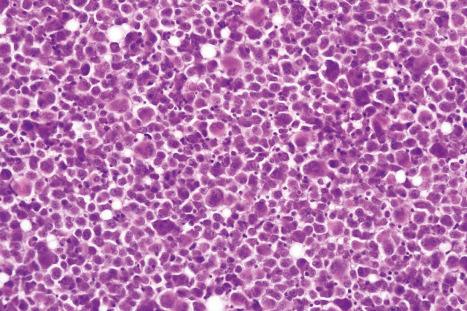
There is wide agreement on the general principles that govern acceptable histologic examination of SN from melanoma patients, but limited consensus on optimum sectioning and staining protocols. Multiple sections should be cut from each half of the SN and stained with hematoxylin and eosin (H&E) and immunohistochemically, using antibodies directed to melanoma-associated epitopes. The number of sections to be stained conventionally and by immunohistochemistry and the interval between sections for evaluation remain subject to debate.
In initial studies of nodal micrometastases, we observed that early melanoma metastases are usually located in a relatively narrow band of tissue adjacent to the longest nodal meridian. Thus carefully sampling the tissues adjacent to the nodal meridian should detect the subgroup of melanoma patients with early nodal metastases. In this study, additional sampling of more peripheral areas of the node did not increase the proportion of melanoma-positive lymph nodes. This is in contrast to other tumors, such as breast cancer, where the tumor cells spread more widely across the nodal surface, and thus more extensive sampling progressively increases the proportion of tumor-positive lymph nodes. On the basis of these findings in lymph nodes from melanoma patients, we have consistently recommended examination of 10 full-face serial sections cut from both faces of the node and stained by H&E (sections 1, 3, 5, and 10), S100 (section 2), HMB-45 (section 4), MART-1 (section 6), and SOX-10 (section 7). Sections 7–9 are retained as spares. If tumor cells are not found in the initial 20 sections cut from both halves of an SN of a patient with a primary melanoma thicker than 1.2 mm (and thus significantly at risk for nodal metastases), additional sections may be prepared and examined, although the yield from this additional evaluation is, in our experience, low. This approach detects melanoma in 16–20% of SNB specimens, a figure that varies according to the thickness of the primary melanomas included in the study group and that is closely similar to the rate of development of clinically detectable metastatic melanoma in the ipsilateral regional lymph nodes of patients observed for up to 10 years after wide excision of a primary melanoma. It is arguable that this relatively simple focused sampling protocol detects most or all of the clinically significant melanoma deposits in SN.
Recent studies, however, have reported that more extended sampling to allow evaluation of sections cut from deeper areas of SN identifies melanoma metastases in some patients where sections closer to the nodal meridian were tumor free. The clinical significance of these additional melanoma cells detected by extended sampling remains unknown, and elucidation of their biology will require that patients be followed for up to 10 years.
Cook and coworkers have reported that examination of six pairs of sections cut at 50-µm intervals and stained respectively with H&E and S100 detects melanoma in up to 33.8% of SNs. Spare sections are cut at each level and retained to permit additional immunohistochemistry in the event of ambiguous results from initial sections. These studies were undertaken because the authors had encountered practical difficulty in accurately cutting the SN through the true meridional plane and wished to reconcile reported differences in the rate of detection of tumor-positive SN by histopathology and molecular techniques (RT-PCR) (see below). A modification of this protocol has recently been adopted by the European Organisation for Research and Treatment of Cancer (EORTC) and is currently a requirement for evaluation of the SN of melanoma patients entering EORTC clinical trials ( Fig. 28.9 ).
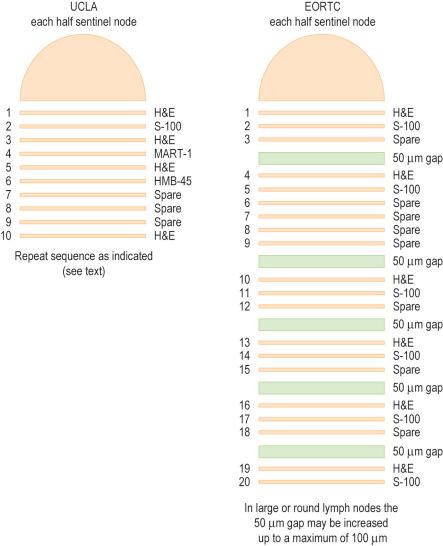
In choosing a protocol for sampling SNs, pathologists, in consultation with their surgical colleagues, should balance the need for accuracy with cost and workload considerations.
It may be extremely difficult to identify single melanoma cells or small clusters of melanoma cells (micrometastases) in H&E-stained sections. Without the assistance of immunohistochemistry, even experienced pathologists may overlook small amounts of tumor in up to 12% of SN specimens ( Fig. 28.10 ). For this reason, and to minimize delays in reporting, immunohistochemical studies are best ordered at the time of initial processing. It is important to be selective in choosing the antibodies to be used in this evaluation. Antibodies to S100 protein detect nuclear and cytoplasmic epitopes in virtually all melanomas, including desmoplastic melanomas (100% sensitive for melanoma), but are relatively non-specific, staining dendritic leukocytes in the nodal paracortex ( Figs 28.11 and 28.12 ), some sinus histiocytes, fat cells within and outside lymph nodes, Schwann cells of node-associated nerves, and capsular/trabecular nevus cells ( Figs 28.13–28.15 ). Some pathologists dislike antibodies to S100 because of this non-specificity, but with experience it is usually relatively easy to separate clusters of dendritic cells (DC) that tend to lie toward the periphery of paracortical nodules from melanoma cells, which are usually larger and nondendritic and are characteristically located in the subcapsular zone and deeper parenchymal tissues ( Figs 28.16 and 28.17 ). Dendritic cells may be encountered in the subcapsular and other nodal sinuses, in which case they are regarded as immature DC (originally Langerhans cells) migrating from the skin to the nodal paracortex. Melanoma cells can be dendritic, but this morphology is usually observed in the radial growth phase of lentiginous melanomas and is exceedingly rare in vertical growth phase or metastatic melanoma. Paradoxically, nodal dendritic leukocytes in some SNs may be poorly dendritic or nondendritic. This is considered to indicate down-regulation of the paracortical dendritic cells as part of the tumor-induced immune suppression that affects SNs. Nondendritic cells are recognized by their location in the nodal paracortex and characteristic immunophenotype: S100 positive, MART-1, SOX-10, and HMB-45 negative.
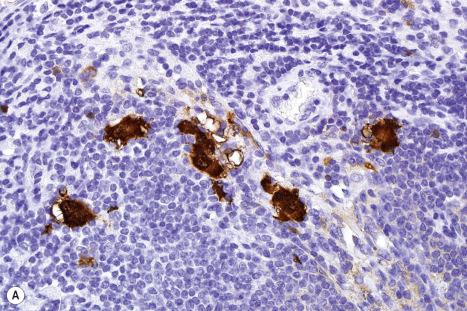
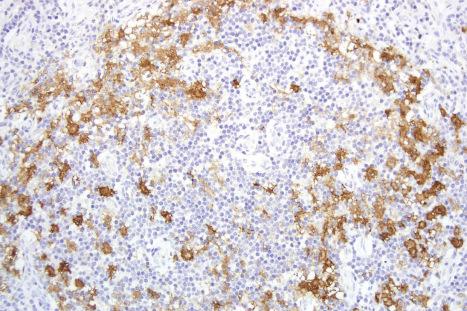
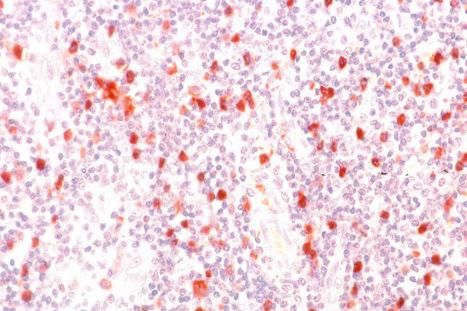
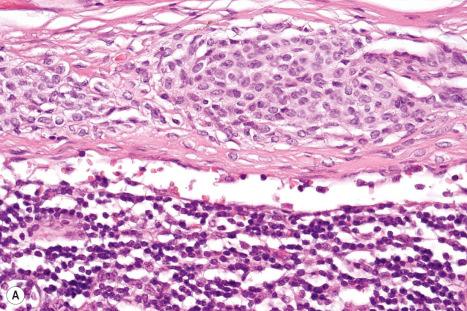
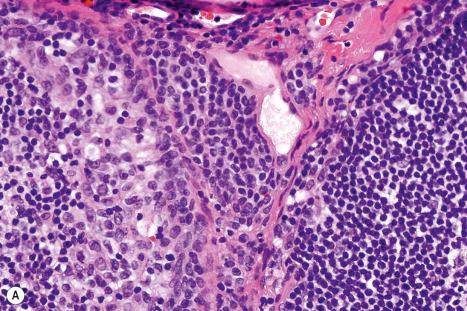
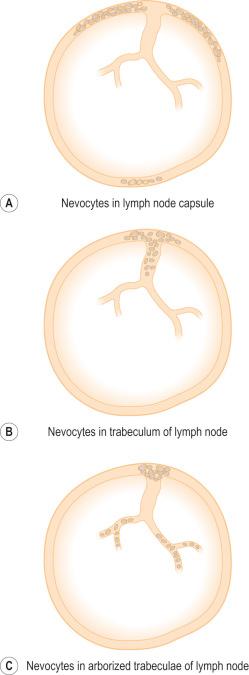
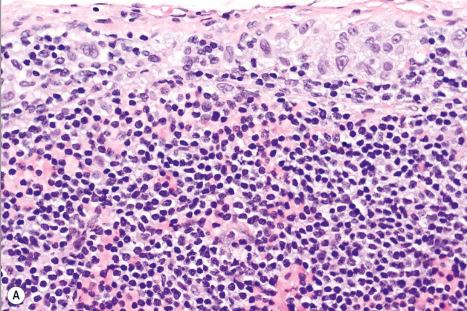
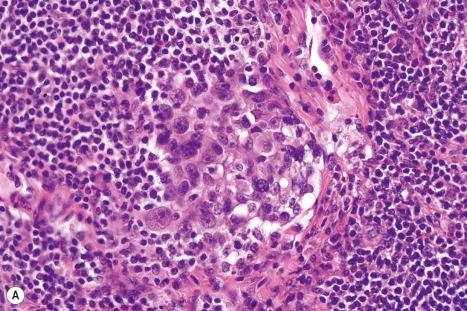
The epitopes detected by MART-1 and HMB-45 are located in the cytoplasm of melanoma and other melanocyte-derived cells. Such epitopes are more specific for cells of melanocytic lineage than S100, but are not expressed by the cells of up to 25% of melanomas, particularly metastatic melanomas. Antityrosinase antibodies are also relatively specific, but of comparably limited sensitivity. There are reports of the use of combinations of antibodies (antibody cocktails), but these seem to be no more sensitive than S100 and do not allow the critical separation of melanoma cells from nevus cells on the basis of immunophenotype (see below).
Pathologist error accounts for some, but not all, cases of false-negative SNB, where – despite a reportedly negative SN – the patient later develops metastatic melanoma in the ipsilateral nodal basin (3–5% in most published series). Such cases may also reflect incorrect identification of the SN by nuclear medicine or at surgery, or a quirk of biology in which, at the time of SNB, the eventually metastatic tumor cells have departed the primary site, but have not yet arrived at the nodal basin. It is highly important to minimize the frequency of false-negative SN as patients in this category have an unfavorable prognosis, comparable to that of patients who develop nodal metastases during a period of observation after wide excision of a primary melanoma.
False-positive assessment of an SN is relatively uncommon, but may lead to patients being subjected to immediate CLND, an operation that is associated with considerably more morbidity than SNB alone and that confers no benefit on patients without nodally metastatic melanoma. False positivity is usually due to misinterpretation of benign cells in the lymph node as melanoma cells. Misidentification often involves macrophages ( Figs 28.18 and 28.19 ), particularly melanin-containing macrophages and macrophages that have phagocytosed melanosomal fragments that express the epitopes of MART-1/Melan-A or HMB-45 released from disrupted melanoma cells, dendritic leukocytes, and capsular and trabecular nodal nevus cells. Confusion between melanin-containing macrophages and immunopositive melanoma cells may be reduced by using a colored chromogen, such as aminoethylcarbazole or alkaline phosphatase (followed by ‘fast red’), in place of brown diaminobenzidine that may be misinterpreted as melanin ( Fig. 28.20 ). However, since colored chromogens are less frequently used, pathologists may find such preparations more difficult to interpret. Other potential sources of false-positivity are S100-positive Schwann cells of intranodal and perinodal nerves ( Fig. 28.21 ), ganglion cells, and mast cells. Distinction of these potential confounding cells is usually achieved by scrutiny of their cytology, their location in or adjacent to the lymph node, and immunophenotype. SNs, particularly inguinal SNs removed from older patients, may show extracellular HMB-45 reactivity associated with calcified foci in the collagen of the nodal trabeculae.
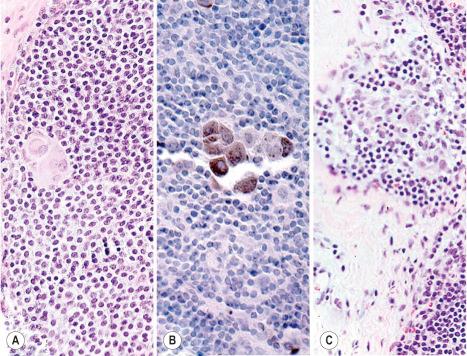
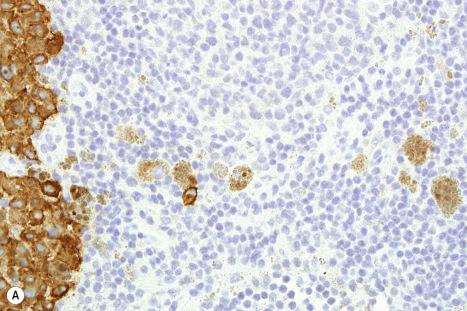
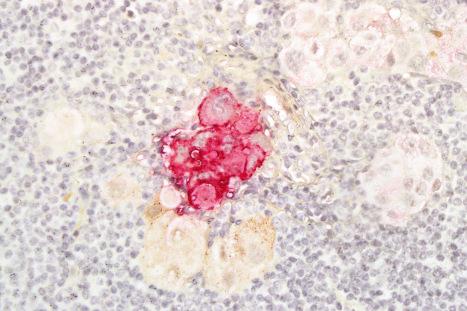
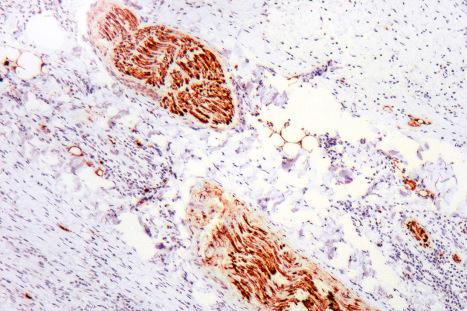
We have encountered an unusual potential cause of a false-positive interpretation of an SN in patients where a small piece of melanoma is included on the slide as a positive control. In rare instances, cells from the positive control tissue may detach and float over to settle on top of the nodal section under evaluation. The keys to identifying these ‘internal floaters’ are to recognize that the tumor cells are not in the plane of the section and then to confirm that the ‘floater’ tumor cells are morphologically and immunophenotypically identical to the cells of the positive control tissue.
It is useful to examine the immunohistochemically stained sections first since MART-1/Melan-A, HMB-45, SOX-10, and S100 protein stains can detect truly small numbers of melanoma cells that are difficult to identify in H&E preparations. The entire slide is scanned at low power, and the different nodal compartments are assessed, starting with the subcapsular sinus, the commonest location of early metastases ( Fig. 28.22 ). Tumor cells may occupy substantial areas of the node or be few, and singly dispersed or organized as microcolonies in subcapsular sinuses, lymphoid parenchyma, and deeper sinuses. The afferent lymphatics should be specifically evaluated for the presence of tumor. Tumor in afferent lymphatics, including intracapsular lymphatics, has the same clinical implications as intranodal tumor and is equivalent to a positive SN ( Fig. 28.23 ). High-power (× 400) fields are examined to confirm the cytology and nature of single or clustered melanocyte-derived cells. Extracapsular extension ( Fig. 28.24 ) is infrequent, especially when the tumor burden is small, but should be recorded if present.
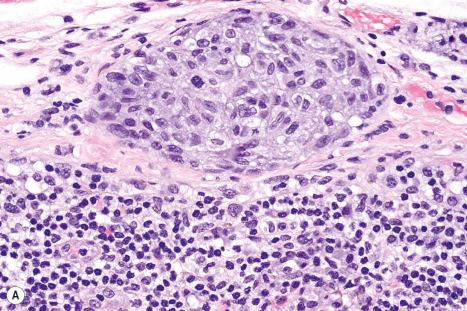
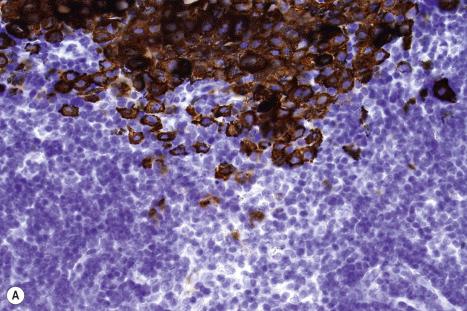
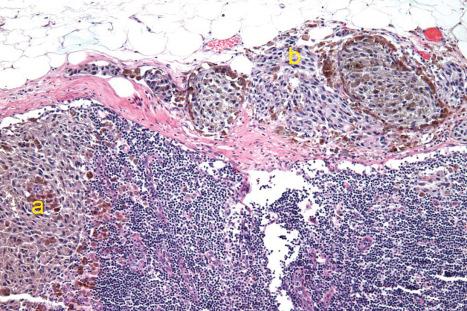
Benign nevus cells can be identified in the connective tissue architecture of up to 24% of lymph nodes, predominantly in the capsule and trabeculae. The great majority of nodal nevus cell collections derive from cutaneous nevi in the catchment area of the lymph node, the nevus cells apparently reaching the node via afferent lymphatics. Careful scrutiny will often show that benign nevi abut and deform adjacent dermal lymphatics. In rare instances, nodal nevi may be the result of aberrant migration of neural crest-derived melanocyte precursors (melanoblasts) during embryogenesis or even of melanocyte stem cells. Accurate discrimination of nodally located benign nevi from melanoma cells is very important. This requires careful consideration of the location of the melanocyte-derived cells in the nodal architecture and detailed assessment of their cytology and immunophenotype. Melanoma cells are mostly larger than nevus cells (although the occasional nevoid melanoma may present a considerable diagnostic challenge) and are commonly located in the subcapsular sinus and deeper lymphoid tissues of the node. Unlike nevus cells, melanoma cells are seldom present in the nodal capsule other than within afferent lymphatics. Cytological features that may be used to distinguish melanoma from nevus cells include large cell size, high nuclear to cytoplasmic ratio, prominent nucleoli, and mitotic figures (especially atypical mitoses). Both melanoma and nevus cells may contain finely dispersed small melanin granules (single melanized melanosomes that are just visible under the microscope) that indicate melanin synthesis within the cell ( Fig. 28.25 ). The amount of melanin in melanoma cells is widely variable, but in most instances (with the notable exception of the cells of heavily melanized cellular blue nevi) is greater than that encountered in the cells of melanocytic nevi. Coarse melanin granules (aggregates of melanosomes that are readily visible under the microscope) are characteristic of melanin-containing macrophages (melanophages), but may be seen, admixed with smaller melanin granules, in some melanoma cells. Melanoma cells are almost always S100 protein-positive (staining of nuclei and cytoplasm), SOX-10 (nuclear staining), most (up to 85%) stain positively for MART-1/Melan-A and HMB-45, and Ki67 reactive nuclei are present at relatively high frequency.
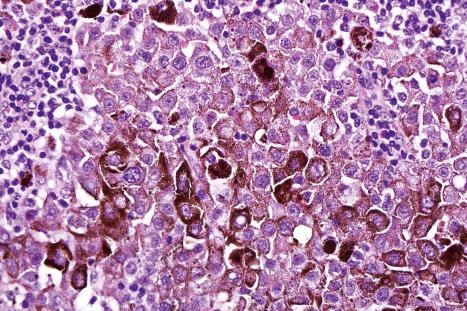
Conventional nodal nevus cells are smaller than most melanoma cells, have limited cytoplasm, usually show only traces of cytoplasmic melanin, and may resemble large lymphocytes. Their nuclei are bland and lack prominent nucleoli or mitoses. They stain positively for S100 protein, SOX-10, MART-1/Melan-A, and P16 , but weakly or negatively for Ki67 and HMB-45. Up to 25% of melanoma patients have capsular or trabecular nevus cells in one or more regional node(s). Location of nevi in connective tissue is usually obvious, although it may be necessary to use a connective tissue stain to rule out extension into the subcapsular parenchyma. Extension of nevi into perivascular stroma or ultrafine reticulations of the trabeculae can make interpretation difficult, because on initial appraisal the nevus cells may appear to be located in the nodal parenchyma, a location that is more characteristic of melanoma metastases. Connective tissue stains such as Masson trichrome and reticulin may help by disclosing the complex arborizing pattern of nodal stroma.
Become a Clinical Tree membership for Full access and enjoy Unlimited articles
If you are a member. Log in here